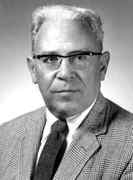Person: Hopf (2), Eberhard

Eberhard Hopf was an Austrian mathematician who made significant contributions in topology and ergodic theory.
Mathematical Profile (Excerpt):
- In 1930 Hopf received a fellowship from the Rockefeller Foundation to study classical mechanics with Birkhoff at Harvard in the United States.
- Another important contribution from this period was the Wiener-Hopf equations, which he developed in collaboration with Norbert Wiener from the Massachusetts Institute of Technology.
- On 14 December 1931, with the help of Norbert Wiener, Hopf joined the Department of Mathematics of the Massachusetts Institute of Technology accepting the position of Assistant Professor.
- While at MIT, Hopf did much of his work on ergodic theory which he published in papers such as Complete Transitivity and the Ergodic Principle (1932), Proof of Gibbs Hypothesis on Statistical Equilibrium (1932) and On Causality, Statistics and Probability (1934).
- In this 1934 paper Hopf discussed the method of arbitrary functions as a foundation for probability and many related concepts.
- Using these concepts Hopf was able to give a unified presentation of many results in ergodic theory that he and others had found since 1931.
- In addition of being an outstanding mathematician, Hopf had the ability to illuminate the most complex subjects for his colleagues and even for non specialists.
- Because of this talent many discoveries and demonstrations of other mathematicians became easier to understand when described by Hopf.
- In 1936, at the end of the MIT contract, Hopf received an offer of full professorship in the University of Leipzig.
- In Leipzig Hopf undertook research on quantic mechanics (1937), Geodesics on manifolds of negative curvature (1939), Statistik der geod (1939) and on the influence of curvature of a closed Riemannian manifold on its topology (1941).
- One important event from this period was the publication of the book Ergodentheorie Ⓣ(Ergodic theory) (1937), most of which was written when Hopf was still at the Massachusetts Institute of Technology.
- In that book containing only 81 pages, Hopf made a precise and elegant summary of ergodic theory.
- In 1940 Hopf was on the list of the invited lecturers to the International Congress of Mathematicians to be held in Cambridge, Massachusetts.
- In 1942 Hopf was drafted to work in the German Aeronautical Institute.
- On 22 February 1949 Hopf became a US citizen.
- In 1971 Hopf was the American Mathematical Society Gibbs Lecturer.
- The measure-theoretical point of view became dominant in the later thirties after the advent of ergodic theory, and the papers of G A Hedlund and E Hopf on the ergodic character of the geodesic flow came into being.
- Hopf was never forgiven by many people for his moving to Germany in 1936, where the Nazi party was already in power.
- An example of this was the dropping of Hopf's name from the discrete version of the so called Wiener-Hopf equations, which are currently referred to as "Wiener filter".
- Hopf's work is also of the greatest importance to the hydrodynamics, theory of turbulence and radiative transfer theory.
Born 4 April 1902, Salzburg, Austria. Died 24 July 1983, Bloomington, Indiana, USA.
View full biography at MacTutor
Tags relevant for this person:
Origin Austria, Topology
Thank you to the contributors under CC BY-SA 4.0! 

- Github:
-

- non-Github:
- @J-J-O'Connor
- @E-F-Robertson
- @Osvaldo-de-Oliveira-Duarte
- @M-Frank
References
Adapted from other CC BY-SA 4.0 Sources:
- O’Connor, John J; Robertson, Edmund F: MacTutor History of Mathematics Archive
